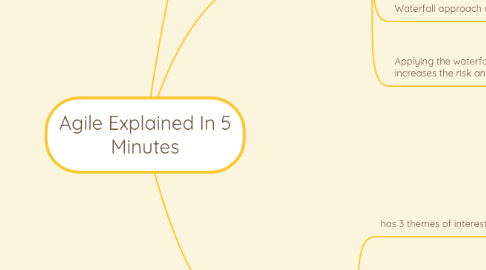
1. Purpose of Agile
1.1. To deliver value to customers faster, cheaper & better
1.2. Minimise bureaucracy
2. History
2.1. Agile emerged in 90s as ALTERNATIVE to waterfall approach
2.2. Waterfall means
2.2.1. document heavy
2.2.2. a plan decided upfront that is enforced and protected with an iron fist
2.2.3. work delivered in large batches
2.2.3.1. in the belief that large batch size is more efficient
2.3. Waterfall approach works when
2.3.1. you can precisely define the ACTUAL end state at the start and the steps required to get there
2.3.2. you don't have surprises along the way
2.4. Applying the waterfall approach in a complex environment significantly increases the risk and chances that a initiative wont be successful
3. Agile
3.1. has 3 themes of interest
3.1.1. Direction
3.1.1.1. Are we clear on the next most important thing to work on?
3.1.1.1.1. Welcome changing requirements, even late in delivery progress. Agile processes harness change for the customer's competitive advantage
3.1.1.1.2. See the whole
3.1.1.2. Are we co-creating solutions rather than taking orders or imposing our solution?
3.1.1.2.1. Customers and team members work together daily
3.1.1.2.2. Shared ownership and equal voice
3.1.2. Focus
3.1.2.1. Are we ACTUALLY working on the most important thing?
3.1.2.1.1. Transparency of work and progress
3.1.2.2. Are we doing too many things to be effective?
3.1.2.2.1. Stop starting and start finishing!
3.1.3. Execution
3.1.3.1. Are we delivering to our commitments?
3.1.3.1.1. Our highest priority is to satisfy the customer through early and continuous delivery of value
3.1.3.1.2. Build projects around motivated individuals. Give them the environment and support they need, and trust them to get the job done
3.1.3.1.3. Delivering concrete value to our customers is the primary measure of progress
3.1.3.2. Are we getting better through experimentation and learning?
3.1.3.2.1. At regular intervals, the team reflects on how to become more effective, then tunes and adjusts its behavior accordingly
3.1.3.2.2. Simplicity-the art of maximizing the amount of work not done
3.1.3.2.3. Make it safe to be curious, experiment & fail
3.1.3.2.4. Radical candour
3.2. has a number of premises
3.2.1. deliver early and often
3.2.2. experiment & learn as fast as possible
3.2.3. create the simplest possible thing that works
3.2.4. treat work in progress as a liability
3.2.5. care and collaborate deeply
3.2.6. ...
